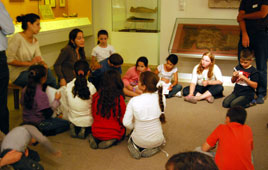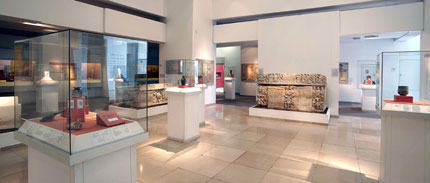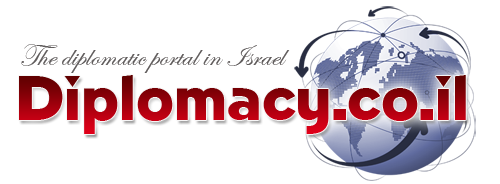Via the MFA

If you happen to be at the Bible Lands Museum in Jerusalem and see an Arab girl holding hands with an Israeli peer, it won't be because of peace talks between the Palestinian Authority and Israel, but the result of a 14-year-old coexistence project.
The museum is not just invested in sharing the treasures of the Abrahamic faiths to the public. Its founder was committed to educating the people whose roots began and stayed in the Holy Land. As part of that initiative, thanks to private donors in the United States, the Bible Lands Museum hosts an annual interactive workshop for two groups of kids who rarely ever meet, if at all: fourth-graders from eastern and western Jerusalem. Though close geographically, they are actually worlds apart
Since 2001, Bible Lands' Yehuda Kaplan, director of educational programs, has overseen this unique kind of interfaith meeting - one that inspires little girls to hold hands as they journey through the museum and learn about each other along the way. Every year there are three or four cycles of meetings for the girls and boys, with each workshop lasting for five sessions. The final meeting includes the children's parents.
Using art, the languages of Arabic and Hebrew, and biblical history, the workshop guides the children in learning about all the things in history that tie them together. All too often, influences in their media, schools and communities emphasize their differences, widening the divide instead of bridging the gap.
The series of workshops starts with an introductory session where the kids learn how to walk (not run), talk and respect the space of a museum. For most of the Arab kids, and some of the Israeli ones, it's the first time they've ever been to any museum.
Then they get to meet each other, and discover to their surprise that the "other" doesn't have a tail, jokes Kaplan. In later sessions, the kids create a piece of art together, inspired by what they see in the galleries. Other activities help them learn about their shared history and where this history diverged.

The project, called "The Image of Abraham" and funded with the support of the Marsha Lilien Gladstein Foundation, is intended to make inroads in mutual respect and understanding between children from different populations. Through the program, the students learn to understand the role of Abraham (or Ibrahim in Arabic), as the same patriarch of both faiths.
Since 2001, Bible Lands' Yehuda Kaplan, director of educational programs, has overseen this unique kind of interfaith meeting - one that inspires little girls to hold hands as they journey through the museum and learn about each other along the way. Every year there are three or four cycles of meetings for the girls and boys, with each workshop lasting for five sessions. The final meeting includes the children's parents.
Using art, the languages of Arabic and Hebrew, and biblical history, the workshop guides the children in learning about all the things in history that tie them together. All too often, influences in their media, schools and communities emphasize their differences, widening the divide instead of bridging the gap.
The series of workshops starts with an introductory session where the kids learn how to walk (not run), talk and respect the space of a museum. For most of the Arab kids, and some of the Israeli ones, it's the first time they've ever been to any museum.
Then they get to meet each other, and discover to their surprise that the "other" doesn't have a tail, jokes Kaplan. In later sessions, the kids create a piece of art together, inspired by what they see in the galleries. Other activities help them learn about their shared history and where this history diverged.
The project, called "The Image of Abraham" and funded with the support of the Marsha Lilien Gladstein Foundation, is intended to make inroads in mutual respect and understanding between children from different populations. Through the program, the students learn to understand the role of Abraham (or Ibrahim in Arabic), as the same patriarch of both faiths.
"Usually we work with fourth-graders, and we notice that the girls combine much easier than the boys," says Kaplan. "It could be their age, or their ability to communicate, but sometimes we see the [Arab and Israeli] girls hand in hand, walking around the museum." During the final ceremonies, the children present their works of art to their parents, who have a chance to interact with one another.
Despite their physical proximity, it's not common for Jerusalem's Jews and Arabs to have normal interactions on a daily basis.
After the sessions are over, "We give them the opportunity to communicate with each other by phone. And since many of the children in the Arab neighborhoods of Jerusalem don't have computers, Internet or Facebook becomes irrelevant. But sometimes they do keep in touch," Kaplan adds.

A mission in education
The intensive program includes guided tours, games and lots of creative workshops about the history of the Near East and what links Arabs and Jews.
"The museum is not-for-profit and puts a lot of its resources into education," says its spokesperson, Ruty Geva. "Dr. Elie Borowski, the founder, had a vision to make the museum into an educational and cultural center for all the faiths [in the region]. And through this project we fulfill his goals by encouraging participants to build something with one another and overcome personal stereotypes to understand the similarities and differences in both communities."
The museum is an attractive venue for tourists interested in artifacts, texts, history and faith-based material at the roots of their faith, be it Judaism, Christianity or Islam. One of its current temporary exhibits is "Angels & Demons: Jewish Magic through the Ages."









